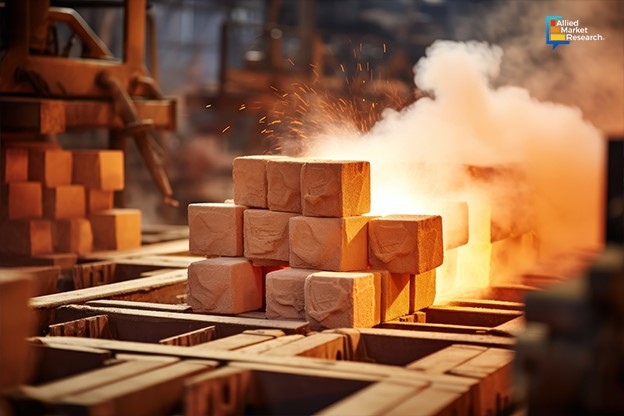Emerging Technologies in the Refractory Materials Industry: Innovations Restructuring Thermal Insulation

12 Aug
2024
Highlights:
- Introduction
- Nanotechnology, ceramics, and refractory metals
- Composite refractories and smart materials
Refractory materials are those that can withstand high temperatures without breaking down. They are used in environments where temperatures exceed 1,000°C (1,832°F). Ceramics, metals, and composites are common types of these materials which are tailored to meet specific industrial requirements. They primarily protect equipment and structures from heat and chemical attacks, ensuring operational effectiveness and safety.
Implementation of advanced materials result in improved efficacy and higher mechanical strength
Nanomaterials offer superior thermal resistance, mechanical strength, and durability compared to conventional refractory materials. Nanostructured materials such as silicon carbide (SiC) and alumina (Al₂O₃) are being used to create refractory linings that offer better thermal insulation. These materials have lower thermal conductivity, which helps in reducing energy loss and improving energy efficiency. Nano-enhanced refractories exhibit improved resistance to thermal shock and wear. This prolongs the lifespan of refractory linings and reduces maintenance costs. Research conducted by the University of Texas at Austin has demonstrated that incorporating nanomaterials into refractory coatings improve their thermal stability and resistance to oxidation, leading to more efficient and durable thermal insulation solutions.
Moreover, developments in advanced ceramics such as zirconia (ZrO₂) and mullite (3Al₂O₃·2SiO₂) are enhancing the performance of refractory materials, providing better insulation and mechanical strength. The creation of porous ceramic structures maintains lower weight and strong shock resistance. Researchers at the Massachusetts Institute of Technology have developed a new class of ceramic composites with micro-structured pores in August 2021, which significantly improve thermal insulation and reduce thermal conductivity while maintaining high mechanical strength.
Refractory metals such as tungsten (W), molybdenum (Mo), and tantalum (Ta) are known for their exceptional high-temperature performance. Refractory metals are used in the construction of furnace components that operate at temperatures exceeding 3,000°C (5,432°F). They provide excellent thermal stability and resistance to thermal degradation. In August 2023, RHI Magnesita, a global leader in refractories, and Heath & Sherwood, a prominent provider of industrial equipment, announced a strategic partnership to enhance the development and application of refractory materials in high-temperature industrial processes. This collaboration used Heath & Sherwood’s innovative monitoring technologies with RHI Magnesita’s expertise in refractory solutions to improve process efficiency, extend refractory lifespan, and optimize operational performance in various industries.
The development of new alloy compositions and processing methods by companies like Plansee and H.C. Starck has improved the performance of refractory metals in high-temperature environments, expanding their application in industries requiring extreme thermal resistance. Furthermore, increasing urbanization, large-scale infrastructure projects, and growth in manufacturing sectors contribute to the expansion of the refractory materials industry.
Multi-layered composite refractories to meet specific industry requirements
Multi-layered composites often feature layers of varied materials to provide enhanced thermal insulation, mechanical strength, and resistance to thermal shock. For instance, a composite might combine a high thermal insulation material with a more wear-resistant surface layer. These refractories are tailored to meet specific industrial needs, such as those in glass manufacturing or steel production. The development of composite refractories by companies like Saint-Gobain has led to the creation of advanced lining systems for steelmaking furnaces, that provide improved performance in terms of both thermal insulation and longevity.
Smart refractories incorporate sensors and monitoring systems to provide real-time data on the performance and condition of refractory materials. Sensors embedded in refractory linings monitor temperature, stress, and chemical exposure. This data allows for predictive maintenance and enhances the safety and efficiency of high-temperature processes. Some smart refractories are designed to adapt their properties based on operational conditions, improving their performance, and extending their service life.
For industries such as metallurgy and ceramics, better insulation leads to lower energy consumption and minimized operational costs. Advanced refractory materials contribute to safer industrial operations by providing better protection against extreme temperatures and chemical exposure. Additionally, enhanced energy efficiency and reduced maintenance contribute to lower environmental impact and reduced carbon emissions.
Ending note
The refractory materials market is undergoing a notable retrieval supported by emerging technologies such as nanotechnology, advanced ceramics, refractory metals, composite refractories, and smart materials. Micro-structured ceramics and high-performance composites upgrade thermal insulation, reducing thermal conductivity, and sustaining superior mechanical strength. These interesting progressions address the growing demand for energy-efficient and eco-conscious industrial processes while expanding the application scope of refractory materials.
To get further market insights and upcoming trends in the refractory materials industry, you can contact our experts now!

Koyel Ghosh
Author’s Bio- Koyel Ghosh is a blogger with a strong passion and enjoys writing in miscellaneous domains, as she believes it lets her explore a wide variety of niches. She has an innate interest in creativity and enjoys experimenting with different writing styles. A writer who never stops imagining, she has been serving the corporate industry for the last five years.
Avenue: Entire Library membership of Allied Market Research Reports at your disposal
- Avenue is an innovative subscription-based online report database.
- Avail an online access to the entire library of syndicated reports on more than 2,000 niche industries and company profiles on more than 12,000 firms across 11 domains.
- A cost-effective model tailored for entrepreneurs, investors, and students & researchers at universities.
- Request customizations, suggest new reports, and avail analyst support as per your requirements.
- Get an access to the library of reports at any time from any device and anywhere.
Related Post
-
How are Submarine Cables Transforming Global Connectivity with Enhanced User Experience?
-
Endoscopy Procedures: Transformations in Techniques and Applications
-
AI-Powered Video Analytics: How the Product Actually Works for enterprises
-
Painting Robots: Transforming Precision Coating and Creative Applications
-
Innovations in Pharmacovigilance Systems Advancing Patient Safety
-
Understanding Edge Security: Keeping Data Safe Near the Source
-
Exploring the Use and Advancements of 3D Laser Scanners in Professional Applications
-
Reinforcing Industrial Controls with Smarter Tools and Training








